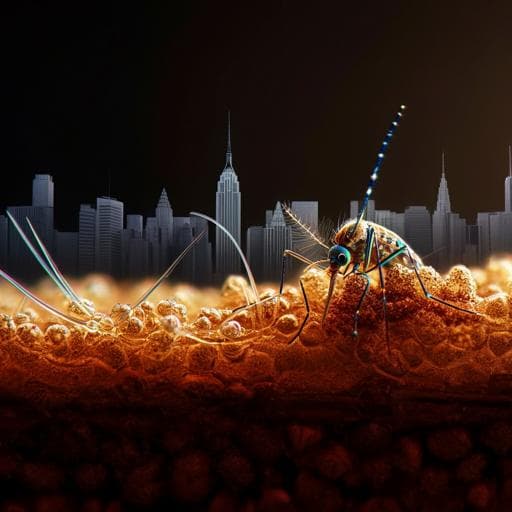
Health and Fitness
The neglected role of relative humidity in the interannual variability of urban malaria in Indian cities
M. Santos-vega, P. P. Martinez, et al.
This study conducted by M. Santos-Vega, P. P. Martinez, K. G. Vaishnav, V. Kohli, V. Desai, M. J. Bouma, and M. Pascual reveals a significant link between relative humidity and urban malaria variability in Indian cities. With insights from years of surveillance data and advanced modeling, the research underscores the critical impact of RH on malaria spread and the challenges posed by climate change on malaria control efforts.
~3 min • Beginner • English
Introduction
The study investigates climatic drivers of the substantial interannual variability observed in seasonal epidemics of urban malaria, focusing on the often-neglected role of relative humidity (RH) compared to temperature and rainfall. Urban malaria in South Asia is driven by Anopheles stephensi, a vector adapted to urban environments and artificial containers, potentially decoupling transmission from rainfall-driven dynamics seen in rural settings. Prior experimental work suggests that mosquito survival and parasite development are affected by temperature and humidity, with transmission favored around 21–32 °C and RH ≥ 60%, and limited when RH falls below ~60% due to reduced mosquito lifespan. Given the sensitivity of transmission to vector survival in unstable malaria regions, and the relatively short lifespan of An. stephensi, RH may critically modulate urban malaria dynamics. The research aims to quantify the role of RH in interannual variability of malaria incidence in two semi-arid Indian cities (Surat and Ahmedabad), contrasting RH with temperature and rainfall using long-term surveillance data and process-based models.
Literature Review
Previous work has extensively examined temperature and rainfall as drivers of vector-borne diseases and their seasonal/interannual variability, including the influence of ENSO. Early entomological research and physiological studies indicated that mosquito longevity, infectivity, and activity increase with higher humidity, and that very low RH can be fatal to mosquitoes. Experimental data suggest optimal malaria transmission around 21–32 °C with RH at least 60%, and that transmission in unstable regions is highly sensitive to vector lifespan. However, most malaria transmission models emphasize temperature dependencies (e.g., parasite sporogony, vector survival/biting) primarily for Anopheles gambiae, with limited incorporation of humidity. Urban settings display strong spatial temperature heterogeneity (urban heat islands), whereas humidity can act as a more spatially homogeneous driver. Prior statistical studies of urban malaria in India have found stronger associations with RH than with temperature at broader spatial scales, yet mechanistic, interannual-scale dynamical effects of RH on incidence have remained underexplored.
Methodology
Data: Monthly Plasmodium falciparum cases for Ahmedabad and Surat from 1997–2014 were compiled from municipal surveillance (active and passive), alongside monthly climate variables (relative humidity, rainfall, temperature) from local stations (IMD Pune) and validated against gridded/satellite products (CHIRPS precipitation; MODIS temperature). Population time series were obtained from municipal estimates.
Analyses: Interannual associations were first explored via lagged correlations between total malaria cases during the transmission season (Aug–Nov) and climate variables averaged or accumulated over pre-season windows. For RH, critical three-month windows preceding the epidemic season were identified (May–July for Ahmedabad; March–July/April–July for Surat per supplementary). Wavelet coherence analysis assessed time-localized co-variability at different periods between malaria cases and RH time series (after low-pass filtering to remove seasonality), with significance determined by bootstrapping (5% level) and cone-of-influence considered.
Transmission model: A stochastic compartmental model for human infection was used, with classes S1 (susceptible), E (exposed), I1 (symptomatic infectious), I2 (asymptomatic infectious), and S2 (partially immune), incorporating demographic processes. Vector dynamics were represented phenomenologically via a gamma-distributed delay between the latent force of infection (generated by current infections) and the realized force of infection on susceptibles, capturing the parasite’s extrinsic incubation period. The transmission rate β(t) included: (i) seasonal structure via six periodic B-splines; (ii) an interannual climate covariate C (RH, temperature, or rainfall) applied to the pre-season spline (S4) corresponding to the window most correlated with seasonal cases; and (iii) environmental process noise (Gamma-distributed). Measurement and process noise were explicitly modeled. Model equations were implemented in a Markovian chain form for the distributed delay to facilitate inference.
Parameter estimation and model selection: Parameters and initial states were estimated via maximum likelihood iterated filtering (MIF) using the R package pomp, based on large ensembles of stochastic simulations. Likelihood-based comparisons (likelihood ratio tests, AIC/DIC) evaluated models with different covariates (RH, temperature, rainfall) vs a null (no climate). Model fit and predictive skill were further assessed via simulations (n=1000) from estimated initial conditions over the full period (retrospective) and via out-of-fit forecasts.
Permutation test: To test for seasonal confounding of the humidity–malaria association, RH data for each month were permuted across years (10,000 permutations with replacement), and correlations between predicted cases and permuted RH windows were computed.
Out-of-fit prediction: Parameters were re-estimated using 1997–2008 as training data. For each subsequent year (2009–2014), updated state estimates (via particle filtering) for January served as initial conditions to generate monthly forecasts (1000 simulations/month), summarizing medians and 10–90% quantiles.
Key Findings
- Wavelet coherence: Significant coherence between malaria incidence and RH at interannual periods (~2 years and ~4 years), predominant at ~2 years in Surat and ~4 years in Ahmedabad, with coherence stronger and more continuous after mid-2000 in Ahmedabad.
- Pre-season RH association: Average RH in a pre-epidemic window is strongly correlated with total cases in Aug–Nov: Ahmedabad R = 0.72 (p = 0.0002; window May–July); Surat R = 0.69 (p = 0.004; window March–July). Correlations with rainfall and temperature were weaker.
- Model comparison (Likelihood-based): Models with RH as an interannual covariate significantly outperformed those with temperature or rainfall and the no-climate model (LRT p < 0.001 for both cities). Example log-likelihoods (Surat): RH -1166.90; Temperature -1176.23; Rainfall -1179.01; No climate -1181.65. Example log-likelihoods (Ahmedabad): RH -1111.31; Temperature -1120.93; Rainfall -1118.21; No climate -1123.98. RH models had superior AIC/DIC.
- Retrospective simulations: The RH-driven model captured the size and sequence of seasonal outbreaks over nearly two decades, including patterns of large outbreaks followed by smaller ones and overall seasonality. Surat’s large epidemics (2001, 2006) coincided with extreme RH and flooding events.
- Predictive performance: Scatterplots of seasonal totals and CRPS analyses showed superior performance of RH models. For Surat, RH outperformed alternatives across all years. For Ahmedabad, RH was best overall, with weaker performance for 2004–2007 and 2010–2012 across all models.
- Transmission metrics: Surat exhibited larger average force of infection and transmission rates than Ahmedabad, with Ahmedabad showing a more pronounced response to RH (higher humidity coefficient). Higher humidity environments corresponded to higher transmission intensity and variance.
- Parameter insights: Estimated mean delay between latent and realized force of infection (proxy for extrinsic incubation period) was ~9 days (Ahmedabad) and ~16 days (Surat), consistent with observed regional temperatures. Other fitted epidemiological timescales (days): exposure-to-infection 24 (Ahmedabad) vs 28 (Surat); recovery 32 vs 38; immunity loss 48.36 vs 38.26; asymptomatic recovery 22.7 vs 18.62; reporting fraction ~0.014–0.015.
- Seasonal confounding test: Only 37 of 10,000 permutations showed stronger correlations than the actual series (P = 2.1 × 10^-4), indicating the humidity–malaria association is unlikely due to seasonal confounding.
- Out-of-fit forecasts (2009–2014): Median predictions closely matched observations, with 76% of monthly observations falling within the 10–90% predictive intervals, demonstrating interannual predictability using pre-season RH.
Discussion
The findings demonstrate that relative humidity is a key driver of interannual variability and seasonal outbreak size in urban malaria in semi-arid Indian cities, outperforming temperature and rainfall as a predictor. This supports and extends early entomological evidence that mosquito survival and activity are sensitive to RH, highlighting a dominant demographic signature at the population level. The RH effect appears spatially more homogeneous than temperature within cities, consistent with urban microclimate heterogeneity where temperature varies strongly due to land-surface properties. In these settings, high pre-monsoon temperatures (linked to lower RH) are inversely related to malaria, while maritime influences can raise RH ahead of rainfall, decoupling RH from precipitation. Accurate interannual forecasts based on RH variability, combined with data assimilation, suggest potential for climate-based early warning systems and for evaluating public health interventions under non-stationary conditions. The study also implies broader relevance to other vector-borne diseases where insect desiccation risk at low RH constrains vector survival. Given projections for increased humidity and precipitation extremes in Northwest India with anthropogenic warming, urban RH increases could intensify malaria transmission, challenging elimination goals, especially as urban centers can act as reservoirs sustaining regional transmission.
Conclusion
This work establishes relative humidity as a critical, previously underappreciated driver of urban malaria dynamics and interannual variability in semi-arid Indian cities. A stochastic, climate-driven transmission model incorporating RH captured historical outbreak dynamics and enabled skillful out-of-fit seasonal predictions. The study provides a foundation for RH-informed early warning systems and for assessing control efforts amid climate variability and change. Future research should: (i) develop experiments to elucidate mechanistic effects of RH on vector and parasite traits and their interactions with temperature; (ii) extend models to explicitly include vector dynamics and microclimate; (iii) assess transferability across cities and finer intra-urban scales, calibrating location-specific parameters; and (iv) integrate hydrological and urban planning factors to mitigate RH-driven transmission risks.
Limitations
- Vector dynamics are not modeled explicitly; the model uses a phenomenological gamma-distributed delay to represent extrinsic incubation, limiting mechanistic attribution of RH effects on specific vector traits.
- Some parameters (e.g., vector carrying capacity) and model calibration are location-specific, potentially limiting generalizability without re-estimation.
- Temperature, rainfall, and humidity are interrelated; despite RH’s superior predictive power, disentangling causal pathways remains challenging.
- Prediction uncertainty arises from both process and measurement noise and from the need to estimate hidden states; performance was weaker in certain periods (e.g., Ahmedabad 2004–2007, 2010–2012).
- Climate station data may have biases relative to city-wide conditions; though validated with gridded products, residual spatial heterogeneity (especially for temperature) may not be fully captured.
Related Publications
Explore these studies to deepen your understanding of the subject.







